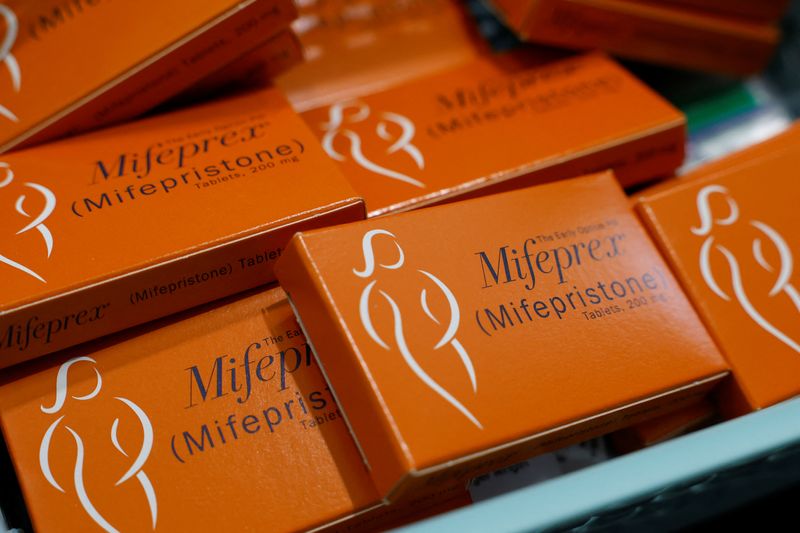US abortion pill access could hinge on whether doctors had right to sue
2023.06.29 07:58
2/2

© Reuters. FILE PHOTO: A container holding boxes of Mifepristone, the first medication in a medical abortion, are prepared for patients at Alamo Women’s Clinic in Carbondale, Illinois, U.S., April 20, 2023. REUTERS/Evelyn Hockstein/File Photo
2/2
By Tom Hals
WILMINGTON, Delaware (Reuters) – A prominent U.S. lawsuit to ban the abortion pill mifepristone has focused on the drug’s safety and approval process. But the outcome may ultimately rest on a different issue: whether Ingrid Skop, an anti-abortion doctor in Texas, and other physicians behind the lawsuit can justify suing in the first place.
That’s because of the legal concept known as standing, which holds that plaintiffs must have suffered harm or face an imminent injury traceable to the defendant — in this case, the U.S. Food and Drug Administration, which approved the pill in 2000.
The deeply divisive issue of abortion rights in America has returned to the national spotlight since the U.S. Supreme Court last year overturned its landmark 1973 Roe v. Wade decision that had legalized the procedure nationwide. Since then, 14 states have enacted near-total abortion bans.
Skop and 10 other doctors submitted their testimony when the case began in November. She said she was harmed by the FDA expanding access to the pill because she has treated dozens of women at her hospital’s emergency room with mifepristone complications.
Skop said that diverted her attention from her primary practice of caring for women in labor. She said she might also have to surgically complete an elective abortion, which would violate her so-called conscience rights that protect doctors from being forced to provide care they morally oppose.
Some legal experts said Skop’s rationale, and that of the other doctors behind the lawsuit, doesn’t meet the bar for standing because the connection between the FDA’s approval of the pill and the alleged harm is too far removed.
If courts were to adopt the plaintiffs’ argument for standing, these experts said, emergency room doctors could sue over almost any regulation that impacted their workload, from oversight of guns to alcohol to teen drivers.
“The plaintiffs have not come close to establishing standing,” said Leah Litman, a professor at the University of Michigan Law School, who is not involved in the case. “I would hope it ends up being a major factor in how this case gets decided.”
Erin Hawley, an attorney with the Alliance Defending Freedom legal organization representing the plaintiffs, said abortion sets the case apart.
“The doctors are being required through emergency situations to treat women, with the result that they feel complicit in taking the life of an unborn child, for no medical reason,” said Hawley.
The FDA declined to comment.
‘CERTAINLY IMPENDING’
During oral arguments in May, the FDA urged a three-judge panel on a federal appeals court to dismiss the case for a lack of standing, without considering the merits.
A ruling could come any time and legal experts say the case is likely to eventually wind its way to the Supreme Court.
The case was brought last year by doctors and anti-abortion groups such the Alliance for Hippocratic Medicine in the U.S. District Court in Amarillo, Texas, with some of the doctors testifying on behalf of the organizations. In two initial rulings, the case was allowed to proceed.
In April, U.S. District Judge Matthew Kacsmaryk in Amarillo ordered the drug’s approval be put on hold. If that ruling is upheld during the ongoing appeals process the drug could be removed from the market or its access restricted.
Kacsmaryk, a former Christian legal activist, and a separate panel of the 5th Circuit Court of Appeals, found the plaintiffs have standing based on the doctors’ testimony.
At oral arguments in the appeal to Kacsmaryk’s April ruling, judges on the U.S. Fifth Circuit Court of Appeals in New Orleans grilled both sides about standing, repeatedly referring to the testimony by Skop.
Courts have decided major cases on the right to sue and the Supreme Court this month said that Texas and Louisiana lacked standing to challenge a Biden administration immigration policy.
One key element has been Supreme Court Justice Samuel Alito’s words in a 2013 case known as Clapper v Amnesty International that plaintiffs cannot manufacture standing “based on their fears of hypothetical future harm that is not certainly impending.”
In the abortion pill case, the two initial court rulings found harm to Skop and other doctors was “impending” because the mifepristone label says the treatment may be unsuccessful in up 7% of women.
In the earlier decision from the 5th Circuit Court of Appeals, the judges wrote that the warning label said up to 7% of women need emergency care, or up to 350,000 of the 5 million women who have used the drug.
The FDA said that was a misreading of the label which indicates the procedure will be unsuccessful in up to 7% of women. In such cases, the label instructs women to consult with their provider about a surgical abortion and the FDA said in a court filing other alternatives include allowing more time for the procedure to complete.
According to a brief by mifepristone maker Danco Laboratories, only 878 of the first 2.5 million women in the United States to use the drug were hospitalized in the first 15 years it was on the market.
Even if 350,000 women over the past 23 years needed emergency treatment, spreading that care over the 15,000 emergency rooms and urgent care centers in the United States averages about one woman per center per year.
“Whatever ‘certainly impending’ is,” Danco said in its brief, “it is more than a fraction of a fraction of a percentage of possibility.”








